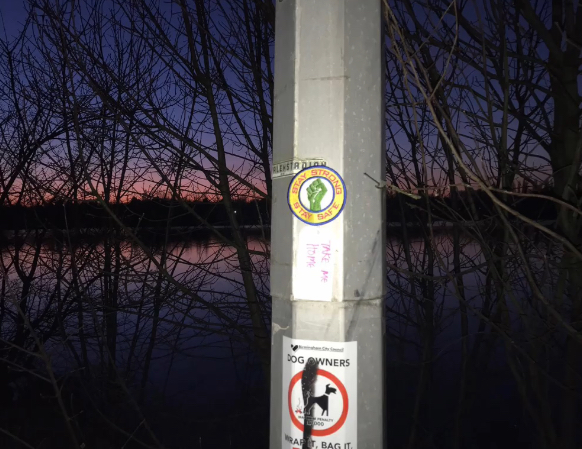 |
| Recovery Quilt 1: Let Go |
This is my article in the July/August edition of Embroidery Magazine. Many thanks to editor Jo Hall for allowing me to republish this
2016/17 was a bad year for me; our house suffered a major
flood and the subsequent refit was handled so badly that we had to get my MP
and the financial ombudsman involved; family members were very seriously ill;
there was a row that alienated me from my family for a year. When a professional disappointment happened
after working on it for 18 months I crumpled; I buckled; I went under.
I was in a very dark place.
In the past when I had been in rough spots, my practice had always been
the safety valve. I had repeatedly used
metaphor as a way to express my thoughts.
Symbolic animals running for their lives; blocks of dark colours overpowering
ambiguous shapes. This time it was different.
I had ‘maker's block’. I couldn’t work and felt like I was looking into a
void. Writer William Stryon, compared
depression to being “imprisoned in a fiercely overheated room”,
but for me it was a crushing sensation.
I felt overwhelmed by the weight of failure; I couldn’t breathe. Not like a panic attack but as if all the
oxygen was being squeezed out of me.
I had been doing some mentoring for the Crafts Council as
part of their Parallel Practice residencies with thread based artist Angela
Maddocks. As the project drew to an end
we agreed to continue with a reciprocal agreement to mentor each other. It took a number of months to actually admit
how ‘stuck’ I was. By now I was on anti-depressants
and in a talking therapy programme but I still had nothing to work on. In a conversation with Angela I found myself
ranting about all sorts of things ranging from the aftermath of the flood,
politics, a perceived lack of success and homophobia I had suffered twenty
years earlier and Angela said in a neighbourly way ‘Oooo. What are you going to
do with all that anger?’ as if it was a tangible thing; something that could be
picked up and carried and moulded into something else.
And I didn’t have an answer but those words buzzed around my
head like a bluebottle in a jam jar. As
it circled in my brain I repeatedly asked myself ‘What will you do with your
anger?’
In the previous five years I had done commissions exploring
leukaemia and blood disorders, cardiology and residencies looking at crippling
bone diseases or working with prosthetic limbs.
It was heavy going. My colour
palette had gone from richly saturated hues to dark, dour monochrome. Whilst my
work wasn’t making me ill it certainly hadn’t been helping.
So I decided I would work with colour again. Bright, vivid
colour. It didn’t matter what I made,
but it would be for me. It wasn’t for a
client, or a community, or in response to someone else’s brief. There would be no serious story to tell; it
would be for my own pleasure; it would be about the joy of just making. And then it became apparent that what I
needed to do was to make a quilt that asked in joyful colours ‘What will you do
with your anger?’
Two weeks later at sewing show I bought a pack of charms (5
inch squares) of Japanese Yuzen fabric.
They were perfect; a confection of jewel like colours, cherry blossom
and chrysanthemums, flying cranes and patterned fans, all laced with fine
golden print. To start with I was
hesitant. I hadn’t made for nearly a
year. I collaged with photocopies of the
fabric but I rapidly dived in.
There were only two rules.
‘Technically slick’ and ‘Choose the more joyful option’.
Letters were digitised from scratch, sometimes with puddles
of metallic thread stitched in splatters alongside, then stitched onto blocks
that were pieced and freemotion quilted. When faced with an aesthetic dilemma
the solution was simple; go for the joyful option.
And it worked. The
simple act of making for myself, not the audience, helped me rebuild
myself. I wasn’t over thinking the
process, just doing, trying to swim in the happiness of pinks, yellows and
turquoise. Of course this wasn’t just
the quilts that bought about my recovery but they were emblematic of the
journey back.
Considering I was making them for me and no one else, they
have been exceptionally well received.
The first two are currently on a European tour and the third was commended
on the shortlist for the Vlieseline Fine Art Textile Award in 2018. Another three
sit in pieces in my studio and I have made three quilts as a personal response
to Covid. I don’t know when I will get to show them but at the moment that
doesn’t matter. When collectors wanted
to buy the very first Recovery Quilt I realised I couldn’t let it go and made them
another version. The irony is that quilt’s
title is ‘Let go’. Its too precious to
me because of the emotional significance in the blocks of bright blossoms,
swirls and splatters of gold. I’ll never let that one go.
Two of Karina’s quilts
are part of the Quilt Art touring exhibitions Material Evidence and Traces
Museum De Kantfabriek,
Horst, the Netherlands, 2nd May - 26th September 2021
Handwerksmuseum, Deggendorf, Germany, end of November 2021 - March 2022
Vänermuseet, Lidköping, Sweden, 1 - 30 September 2021







